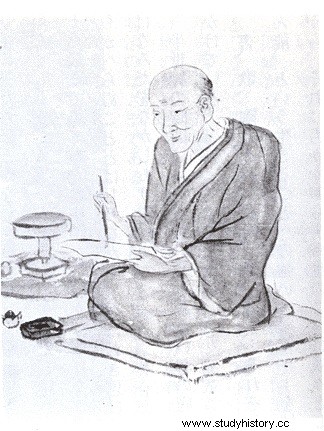Comprehensive artist, painter, calligrapher, potter, dancer, seamstress, practitioner of martial arts and Buddhist nun, Ōtagaki Rengetsu (1791 – 1875) is one of the most important Japanese poetesses of her time.
Daughter of a geisha and a samurai

Probably the daughter of a geisha, Ōtagaki Rengetsu – then called Nobu, Rengetsu being her nun name – was born on February 10, 1791 in Kyoto, during the Edo period in Japan. Coming from a samurai family named Tōdō, she was adopted in her early childhood by the samurai Ōtagaki Teruhisa. Lively and intelligent, the child receives a good education that allows him to develop his talents, especially in poetry, literature and calligraphy. She is also taught martial arts, which she is also proficient in.
The child then becomes a lady companion at Kameoka Castle, in the city of Hirado in southern Japan; she continued her apprenticeship in the traditional arts. Ōtagaki Rengetsu particularly excels in the art of waka poetry. , short poems. But she also practices dance, sewing or the tea ceremony. The young girl remained at Kameoka Castle until the age of 16, when she married for the first time.
Lotus-Moon
The marital and family life of Ōtagaki Rengetsu, who has already lost his adoptive mother and brother, is filled with pain, sorrow and bereavement. Her first marriage is unhappy, and the three children she has with an abusive husband die shortly after birth. In 1819, she married again. With her new husband, she will have two children but is not at the end of her trials:while she is pregnant with the couple's second child, her husband dies in 1823 and she finds herself a widow again, before losing her two children.
Alone, bruised, Ōtagaki Rengetsu seeks to overcome her pain and restore meaning to her life. Deciding to become a Buddhist nun, she joined the temple of Chion-in in Kyoto and met her father there; it is there that it takes the Buddhist name of Rengetsu meaning “Lotus-Moon”. In Kyoto, Rengetsu wrote poems marked by loss, pain and melancholy, and her talent made her known and recognized by a circle of artists as well as by admirers. She notably frequents Ozawa Roan, Ueda Akinari or even Tomioka Tessai. Beyond poetry, the artist also devotes himself to calligraphy and painting to illustrate his verses.
Poetess and ceramist
Ōtagaki Rengetsu stayed at Chion-in Temple for almost ten years. In 1832, a new ordeal struck her through the death of her adoptive father. To support herself, in addition to poetry and calligraphy pieces, she makes bowls in which she paints or engraves her poems before selling them at the market; her technique does not match that of professionals, but the beauty of her words, the harmony of her work and the heart she puts into the work make them unique pieces that meet with great success. Not only does Rengetsu live from her art, but she recruits assistants to be able to meet the demand. She was, in fact, so successful that, despite her desire for a quiet and solitary life, she received many visits from other artists and admirers.
It is in particular this desire for calm and isolation that pushes Rengetsu to move regularly and to settle in other temples, until the age of 74 when she finds refuge in the temple of Jinkō-in in Kyoto. . It was there that she died ten years later, in 1875. Her art survives her, her poetry earning her recognition as one of the greatest poetesses of her time and her ceramic work remaining imitated after her death. .
Works by Ōtagaki Rengetsu
"The oars beat to the rhythm
From the fisherman's song
Sung with a light heart
The moon floating high
Above his fishing boat”
"The Evanescence of
This floating world
I feel it again and again:
The biggest difficulty
Is being the one who stays. »
